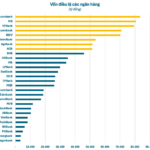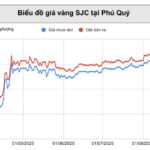A day after the government issued Decree 232/2025/ND-CP (Decree 232) amending and supplementing Decree 24/2012/ND-CP on the management of gold business activities, the domestic gold market recorded prices that were still much higher than the world market.
Gold prices continue to rise
At the end of August 27, large gold enterprises listed the price of SJC gold bars at 126 million VND/tael for buyers and 128 million VND/tael for sellers, an increase of 300,000 VND/tael compared to the previous session.
This continues to be the historical peak for SJC gold bars. Meanwhile, 99.99% gold rings and jewelry followed the same trend, hovering around 119.9 million VND/tael for buyers and 122.4 million VND/tael for sellers, up 200,000 VND from the previous day.

Many people still lined up to wait for their turn to buy gold rings and bars at SJC Company on August 27. Photo: Thai Phuong
However, the actual records at the headquarters of Saigon Jewelry Company (SJC) in Ho Chi Minh City showed that the demand for gold bars remained very high. Even in the morning of August 27, many people lined up to buy gold, but each customer was only allowed to purchase a maximum of one tael of gold bars due to limited supply.
Around 10 am, the company announced that they had run out of gold bars, so some people quietly left, while others switched to buying plain gold rings, but each person was only allowed to buy one unit of gold rings through transfer and one unit with cash.
In the afternoon, both gold bars and rings were scarce, and employees had to announce a temporary suspension of sales pending the replenishment of supply. “After the information about Decree 232 was released, some customers brought gold to sell due to concerns about a possible price drop, but the number of buyers still outnumbered sellers. This has prevented prices from falling sharply as expected and has even pushed them higher in line with the global market. If more gold was sold, the company would have had enough gold to meet the demand, but now there is almost none left,” shared an employee.
Mr. Nguyen Ngoc Trong, Director of New Partner Gold Company (NPJ), opined that the main reason for this scarcity was not necessarily due to high demand but rather a lack of supply. “The price of SJC gold bars is currently 20 million VND/tael higher than the world market, equivalent to a difference of 18.5%, a record high never seen before. Meanwhile, the government’s management objective is to narrow this gap to 1%-2%.
If timely intervention measures are implemented, the prices will cool down significantly. In the past, there were days when the market dropped by 5 million VND/tael when the management agency intervened in sales. But at present, the market is still waiting for specific actions, while enterprises do not have gold to sell, leading to higher prices,” said Mr. Trong.
Entering a “new game”
Nevertheless, domestic gold businesses are still very hopeful that the new management mechanism will create healthy competition and bring domestic gold prices closer to world prices.
“When multiple units participate in the supply chain, the source of gold will become more abundant, and domestic gold prices will move closer to world prices. There will no longer be gaps that cause anxiety among people and disrupt the market, as the dominance of a single unit in the entire supply chain can create distortions, whether intentional or unintentional,” expressed the director of a gold enterprise in Ho Chi Minh City.
This person opined that when the supply is diversified, the market will better reflect the actual supply and demand, limiting the influence of psychological factors or rumors on prices. The new decree also demonstrates the government’s efforts to create a level playing field for private enterprises, which has been long-awaited. More importantly, as domestic gold prices narrow the gap with world prices, the vast gold reserves held by the public can be unlocked, providing a boost to the economy.
Mr. Nguyen Duc Anh, Director of Business Development of Bao Tin Manh Hai Gold and Jewelry Joint Stock Company, assessed that ending the monopoly on gold bars at this point is “ripe” because the market has endured scarcity for too long. “The most important thing is to ensure a stable supply, thereby stabilizing gold prices and bringing them closer to world prices, addressing a significant issue in the market in recent years. We expect gold prices to move closer to world prices,” shared Mr. Duc Anh.
However, he also acknowledged that not all enterprises can immediately enter the market because, in addition to capital, units also need infrastructure, technology, quality control processes, and, most importantly, brand reputation to obtain a license.
Mr. Anh shared that Bao Tin Manh Hai also has a roadmap for capital increase to meet the conditions for gold bar production. Investing in infrastructure and expanding the distribution system for gold bars in many localities is a must and cannot rely solely on existing resources. This means that while the new decree opens up opportunities, the “ticket” to enter the game is not easy.
Awaiting New Supply
However, the question arises as to when the market will have SJC gold bars from new imported gold materials. According to a representative of a gold company, this depends on the speed of licensing by the State Bank (SBV). For enterprises that already have production workshops and experience in gold processing, the process can be expedited.
However, for commercial banks that have never participated in gold bar production, investing in the construction of factories, technology, and management processes will take a significant amount of time. “Depending on their strategies, these entities will consider whether to enter the market and the scale of their participation,” the representative said.
Mr. Huynh Trung Khanh, Senior Advisor to the World Gold Council in Vietnam, recommended that the management agency soon issue criteria and import quotas for each unit to quickly bring new supplies to the market. According to him, enterprises and banks will have to report their expected gold material requirements for one year, based on which the SBV will calculate the total amount of gold to be imported.
“This process cannot happen overnight, so the price of SJC gold bars cannot decrease immediately as expected. In 2024, for example, the SBV supplied 354,100 taels of gold bars, equivalent to 13 tons of gold, to the market within seven months, but this figure did not fully reflect the actual demand of the people,” said Mr. Khanh.
Statistics from the Vietnam Gold Traders Association (VGTA) show that the demand for gold materials to produce gold bars and jewelry averages about 50 tons/year, equivalent to 5 billion USD. Of this, about half is used to meet domestic needs, while the rest is for export. Jewelry exports alone can bring in 3.5-4 billion USD/year.
This means that if the import mechanism is implemented smoothly, Vietnam will not only have additional gold supply for the domestic market but also take advantage of export opportunities to earn foreign currency.
Regarding concerns that the amount of foreign currency used to import gold will put pressure on the foreign exchange market, VGTA believes that the figure of 5 billion USD/year is insignificant. On average, enterprises need about 416 million USD per month to import gold, while transactions in the interbank foreign exchange market reach 900 million to 1.2 billion USD per day, or 18.9-25.2 billion USD per month.
Therefore, the demand for gold imports is well within the capacity of the banking system to accommodate and will not affect the foreign exchange supply-demand dynamics or force the State to use foreign exchange reserves for intervention.
Avoiding Risks and Ensuring Sustainability
According to Decree 232/2025/ND-CP, the SBV will license commercial banks and enterprises that meet the conditions to produce gold bars and allow the import of gold materials for production. The conditions set are not easy: enterprises must have a charter capital of VND 1,000 billion or more, while commercial banks must reach VND 50,000 billion.
With such high requirements, the number of units that can initially participate in the market is limited, mainly large banks such as Vietcombank, VietinBank, VPBank, Techcombank, BIDV, MB, and leading enterprises like SJC, PNJ, and DOJI. The SBV explained that the reason for setting such high capital criteria is to ensure that only organizations with strong financial capacity, management experience, and reputation are allowed to produce gold bars, thereby avoiding risks and ensuring the sustainability of the market. This also allows the State to maintain its supervisory and management role while expanding opportunities for private enterprises to participate.
Opening up Export Opportunities
Mr. Le Chanh, owner of a private gold business in Cho Ba Chieu (Ho Chi Minh City), opined that the regulation requiring units to use electronic invoices when buying and selling gold materials and connect transaction information with the SBV is a necessary step to transparentize transactions. This not only limits the use of gold for illegal activities but also opens up opportunities for gold exports in the future. “With a stable source of materials and a favorable market, enterprises can export gold and earn USD, offsetting the foreign currency used for gold imports,” Mr. Chanh analyzed.
According to Mr. Chanh, small gold shops, although unable to directly import gold materials, will still benefit from the new mechanism by accessing quality gold sources from large units at reasonable prices. “From there, gold shops can focus on design and jewelry processing to better compete with big brands,” he said.
The Golden Opportunity: Unraveling the ‘Strange Move’ of the Gold Enterprise
“The SJC gold bar price surged to a new record high of VND 128 million per tael today, August 27. In a surprising turn of events, gold enterprises drastically slashed their buying prices and even refrained from purchasing gold bars after the exclusivity on gold bar trading was lifted. This unusual move comes as a contrast to their previous aggressive gold-buying spree.”
The Golden Opportunity: Unlocking the Exclusive World of Gold Bullion Production
With the new regulations in place, a substantial increase in minimum charter capital is required for businesses seeking licenses to produce gold bullion. To enter this industry, enterprises must now possess a minimum charter capital of VND 1,000 billion, while banks are required to have VND 50,000 billion.









































